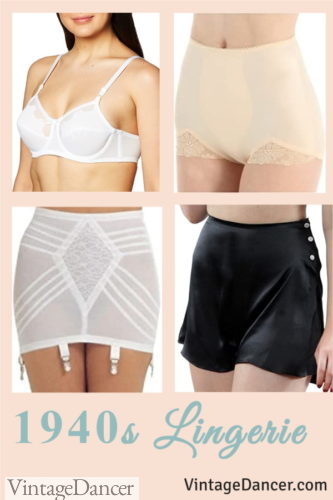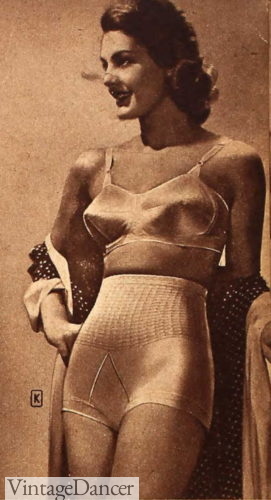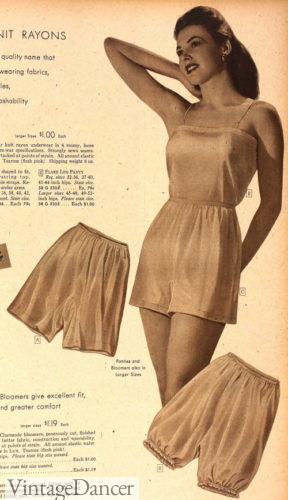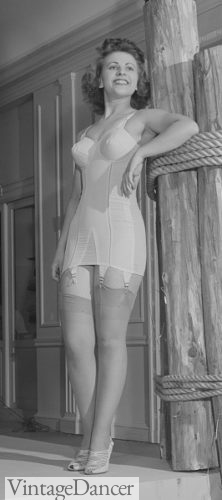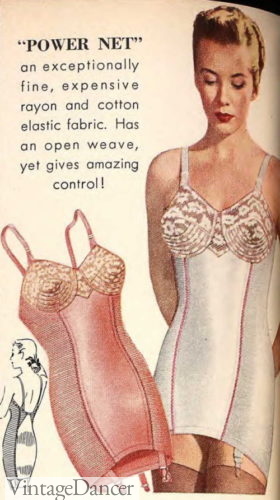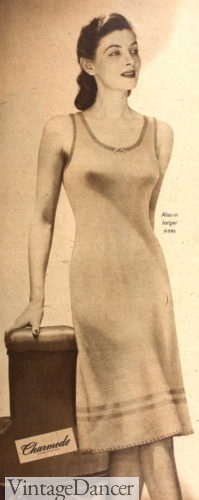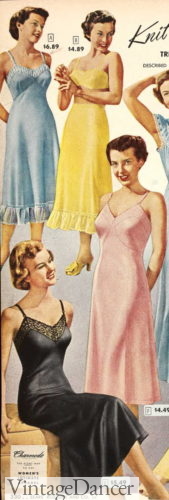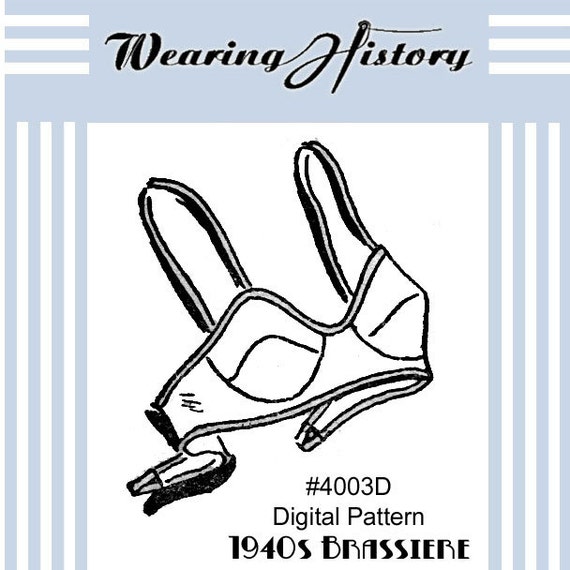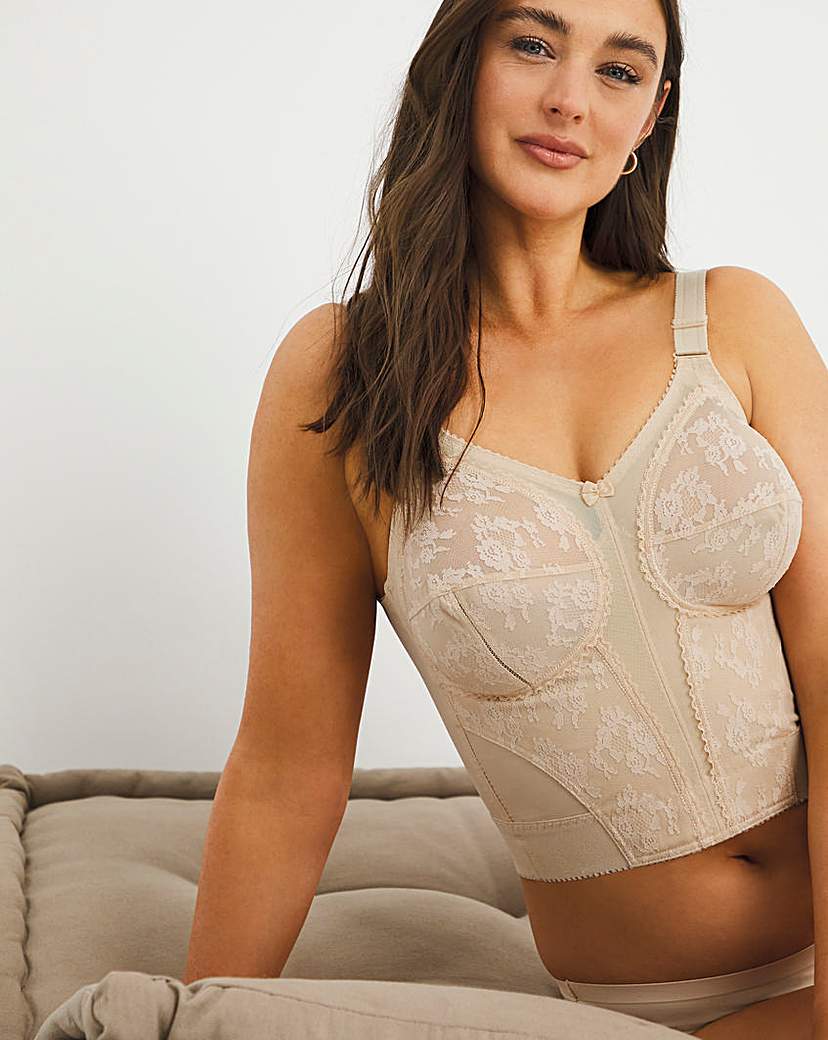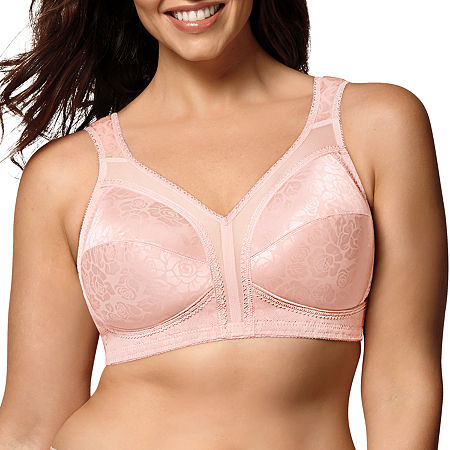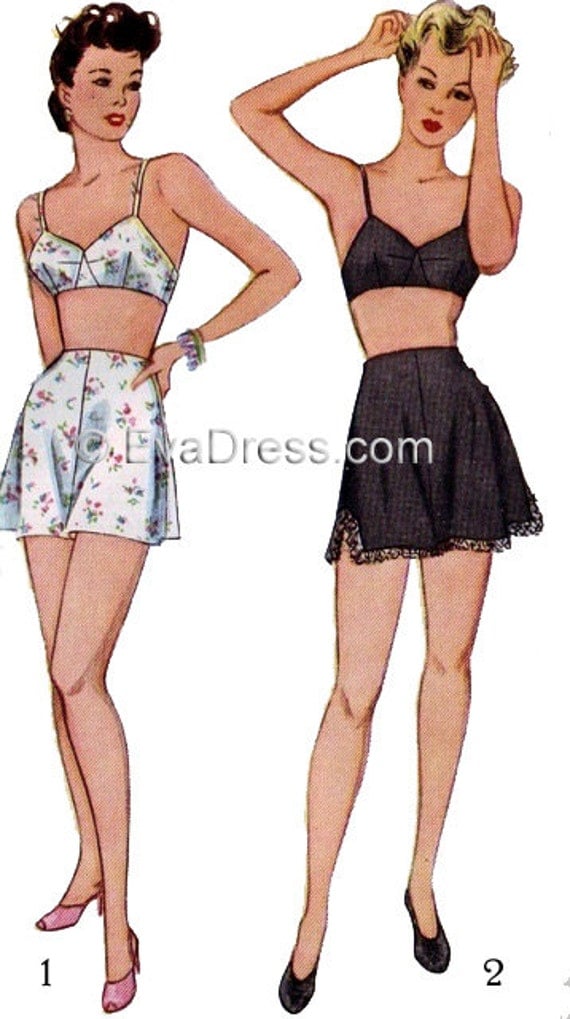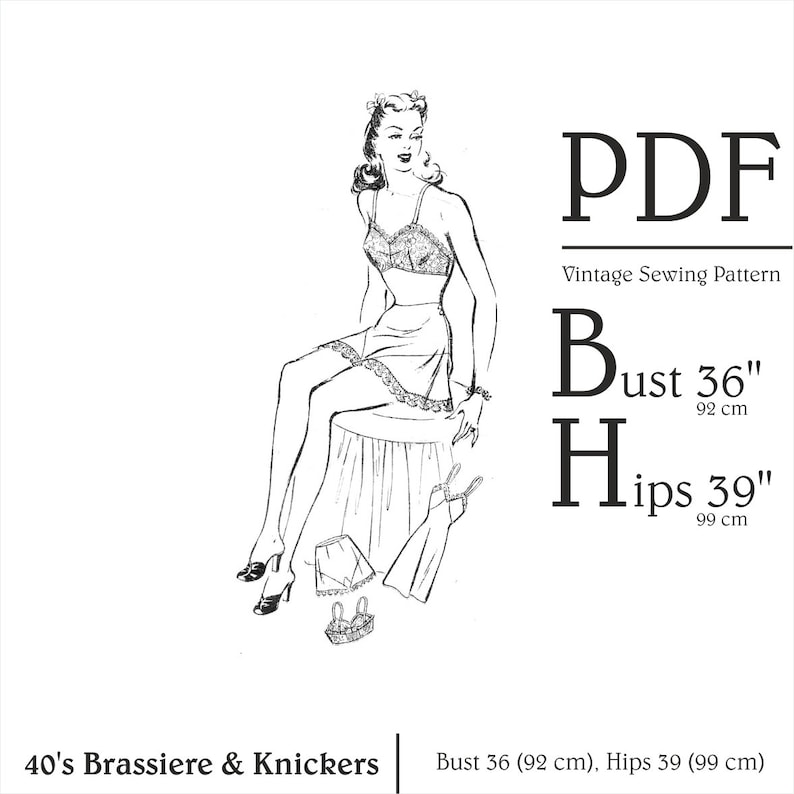“Correct posture with the correct foundation garment combine to give a woman an attractive figure and will aid her in her quest for health and vitality.” Foundations for Fashion, 1948
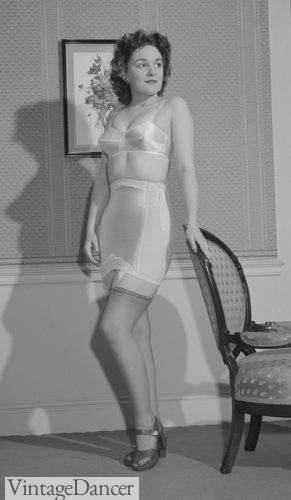
1942 lingerie model at Saks Firth Avenue
When people think of women’s 1940s lingerie, what usually comes to mind are the glamorous, curvy, satin and lace pin-up girls whose pictures filled the magazines popular with lonely soldiers overseas. Beautiful women posed provocatively in corsets, nightgowns and swimsuits with a look that remains iconic today.
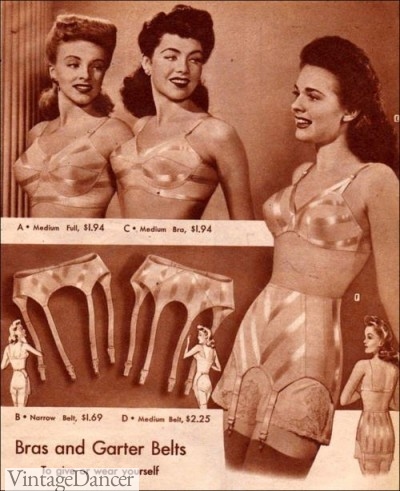
1940s Lingerie
The reality, however, was quite different. Women back home were not lounging around in fancy, restrictive 1940s undergarments. They were out enjoying a new freedom working and being active outside. Because of wartime shortages in materials, they also enjoyed a new freedom in their undergarments.
1940s Lingerie Styles
In the 1930s, women were still wearing metal-boned corsets. New technology soon allowed for girdles to take their place, although corsets continued to be worn in the ’30s. New two-way stretch elastic fabrics were fashioned into snug-fitting, full-body girdles that smoothed every lump and bump.
The ’30s full-body version of the girdle included a bra top that was attached to a very short skirt with elasticized straps with metal fasteners to attach to silk stockings (remember, up until the ’60s, stockings were worn without a top – they came up to mid thigh and had to be held up).
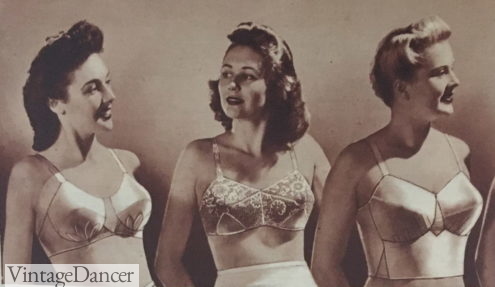
1944 women’s bras
Bras weren’t very advanced – cup sizes were invented in 1935 and the first underwire bra came out in 1938. In the late 1930s, the rubber girdle came out. It really was made out of rubber – yes, rubber – and was covered in ‘breathing’ holes.
The war affected 1940s undergarments just as much as it affected all other aspects of dress. Production of the new rubber girdles came to a halt because rubber was needed for the war. The same went for corsets, as the steel used for the boning was needed. This ended up being an advantage for women who required more flexibility and movement with their new lifestyles.
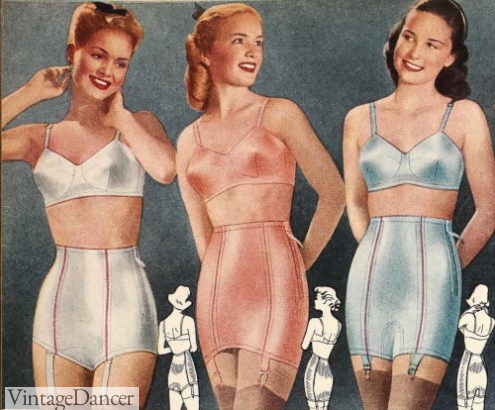
1948 bra and panty girdle sets
While 1940s girdles and corsets look confining to our modern eyes, the purpose was described as follows: “rather than actually constricting the body to meet fashion’s demands for a nipped-in waistline, a molded hipline, via too-tight corsetry, slimming and indentation is created through ingenious designing devices which give the appearance of a slim silhouette.”
Women wanted comfort, not restriction, so lingerie was made to gently provide a structured frame to contain the body, not a sausage casing to stuff the body into. Thank goodness!
Wearing Lingerie
Half of all women in the 1940s wore a one piece brassiere with a girdle over panties. It was simple, affordable and most of all comfortable to wear.
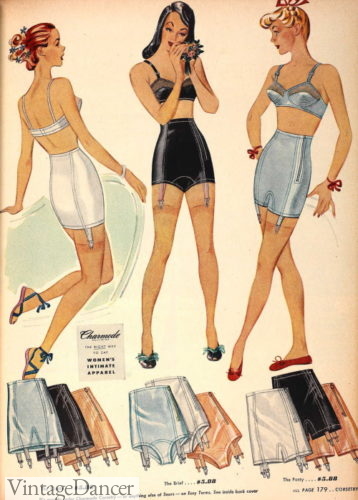
1947 girdles
The Corset Brassiere Association of America reported in 1948 that a typical woman owned three undergarments, five bandeaus, and three long line bras. This was about half of what the Association suggested women own which was 5 hip (girdle) and 10 bust garments (bras).
They figured women needed different combinations and styles of garments for 1. office or home wear, 2. sportswear and 3. evening wear. The suggested options were:
For day wear:
- A girdle and a bra
- Longline bra and girdle
- All in one Combination
- Strapless bra or strap bra and garter belt combo
For sports:
- Cotton or Rayon bandeau bra and pantie girdles that provide optimal movement. Knit materials were more flexible than satin.
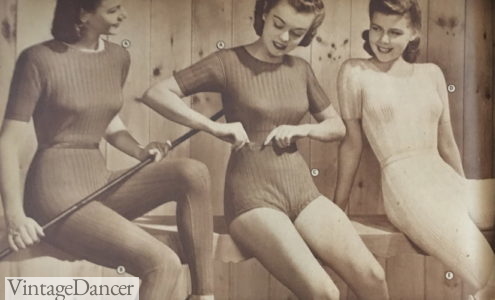
1942 knit underwear for sportswear (Red or blush)
For evening wear:
- An all-in-one or corselette was strapless for youthful figures and with straps for fuller figures. A low back cut out is good for low back gowns.
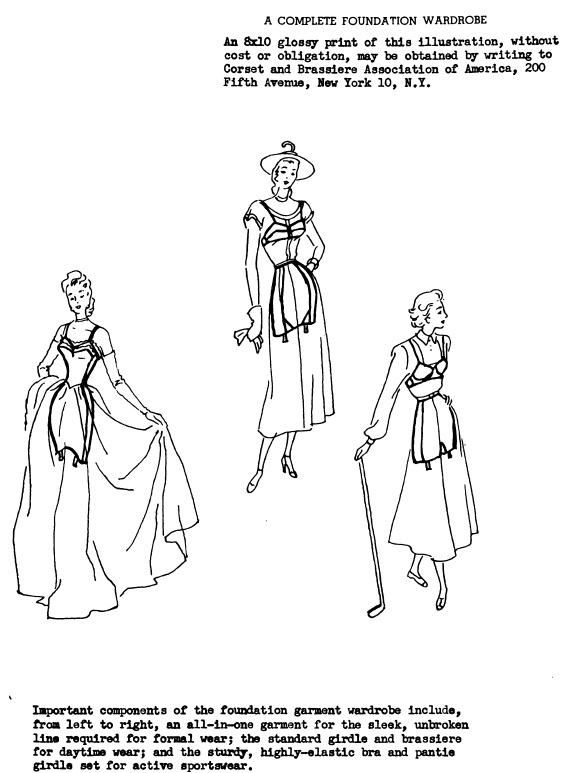
Suggested Lingerie for Casual, Day and Evening Wear
Taking the occasion into consideration was one way to choose garments and body type is the other. Women were sold foundation garments based on fitting into one of four main figure types:
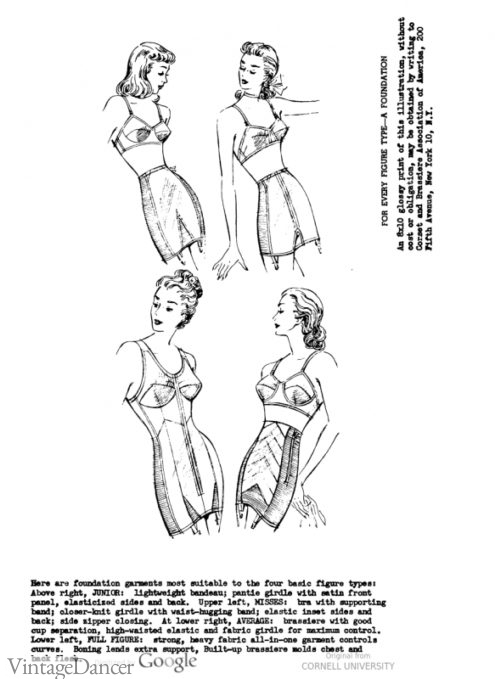
4 Body Types and Suggested Lingerie for Each
4 Body Types and Suggested Lingerie for Each
- Junior: Lightweight bandeau; pantie girdle with satin front panel; elasticized sides and back. Pull on girdles are popular with teens. Girdles with boning on the back help train a girl to have correct posture. Favorite colors are black, nude, yellow and blue with pretty embroidery of flowers.
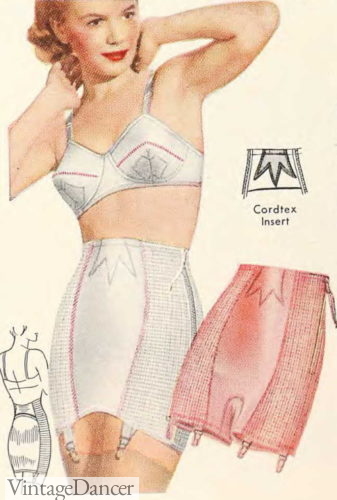
1947 pullon girdle and light bra for teens and young women
- Misses: Bra with supporting band; closer-knit girdle with waist-hugging band; elastic inset sides and back; side zipper closing. A misses’ body is still young and firm, needing little shaping. The ideal measurements of a young woman were height: 5’2″-5’3″, bust: 35.5 inches, waist:29 inches and hips: 38 inches. These ideal numbers grew slightly as woman aged.
- Average: Brassiere with good separation, high waisted elastic and fabric girdle for maximum control. The bra may need thicker shoulder straps to provide appropriate lift and breast separation. Longline bras provide lift without the pressure of shoulder straps. An All-In-One is also ideal for the average body as it both shapes soft flesh and creates curves.

1944 women’s bras- young to mature
- Full figure: Strong, heavy fabric, all-in-one garment controls curves. Boning lends extra support, Built in brassiere molds chest and back flesh. Full figures need an All-In-One to achieve the 1940s silhouette. A version with long thigh coverage is critical to a smooth figure.
Cup sizes didn’t exist in the 1940s like they do now. Instead a woman chose the bra type designed for her body type (above) and then measured around the fullest part of the chest to the back. That number in inches was her bra size. In comparison, today’s measurements involve counting the size of your chest cavity plus cup size- a far more accurate way of measuring.
1940s “Bra” Brassiere
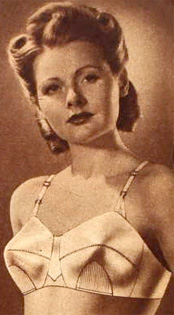
1941 bra
The 1940s brassiere became shortened to the ‘bra.’ Bras of the era were plain without lace or decoration, most frequently made from rayon satin and sometimes cotton. The color was usually white, ivory or the very popular peachy-pink. Straps were adjustable and the bras fastened at the back with metal hooks and eyes, just like those of today.
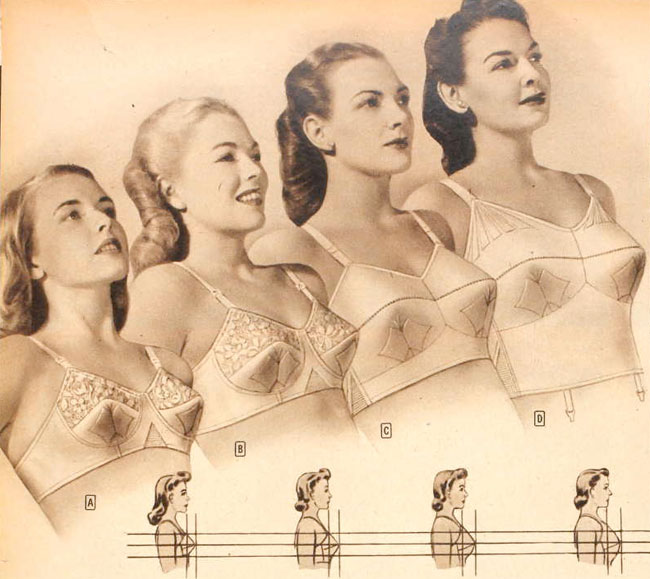
1945 bras for small or full figure busts
The shape of ’40s bra was very different, however. All bras were full-coverage, with a 1-3 inch elastic underbust band reaching all the way from one side to the other. The band usually came down an inch to several inches below the bottom of the bust, covering some torso.
There was also a substantial amount of fabric in the center, creating separation instead of the pushed-together cleavage of today. The straps came from the middle of the cups instead of the sides.
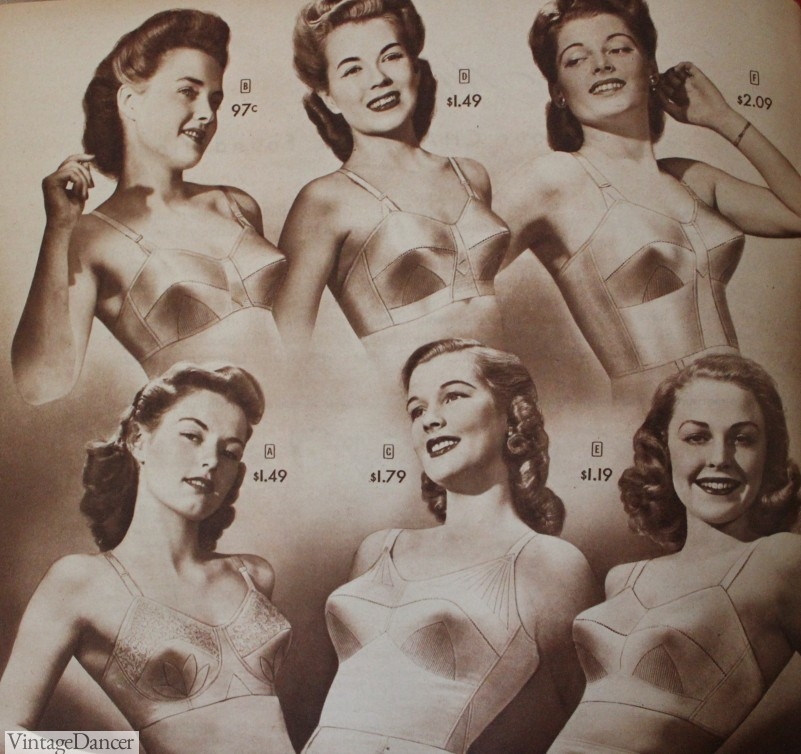
1948 Bras for Average Figures
The shape they created was pointier than today, mostly because the design wasn’t fully developed yet and bra cups had several seams that came together at a point in the center.
For smaller busts a thin fabric was all that was needed (usually called a bandeau instead of brassiere) while fuller bust bras used additional felt padding to create the pointed shape. Underwires did exist but were flexible, not stiff, only adding some support to the materials not necessarily to create the pointed shape.
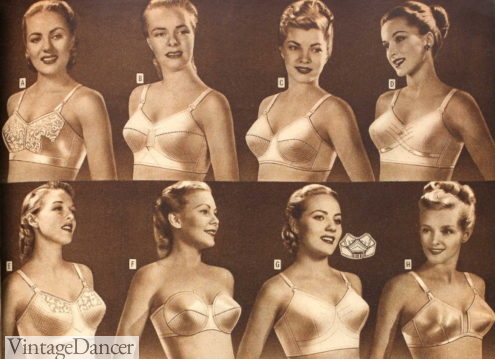
1948 bra styles- from bandeau to longline
In many cases wire was added to the center bust panel to help separate the breasts. For this reason, women used to only wearing underwire bras today will find wearing an un-wired bra an odd feeling at first.
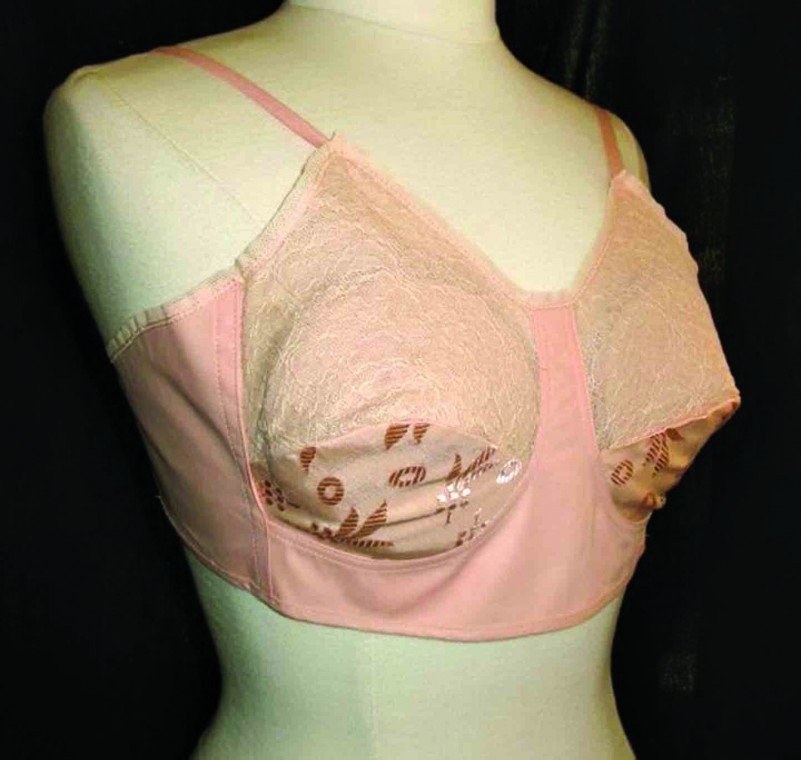
1940s full coverage bra in peachy-pink. Photo courtesy of sewingmachinegirl on Etsy.com
The longline bra is an icon of vintage lingerie, yet rarely worn by women today. It combines the traditional bra top with extra band length that extends to the belly button. The long panel is usually boned to help with posture and bust uplift. The purpose is to smooth out underbust flesh, much like a girdle smooths out tummy flesh.
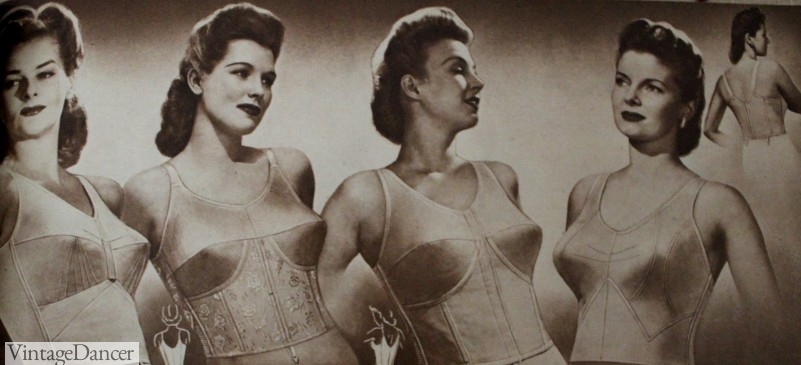
1948 Longline Bras
Most women who are of average figure size wore both a longline bra and girdle together for maximum smoothness. Longline bras were also popular evening styles because they could hold up and support a chest without straps or even a full back. Longer versions of the longline bra, called waistlette bras, extended down to the hips and had garter clips attached. This eliminated the need for a separate garter belt or panty girdles.
The strapless bra was a popular alternative to the 1940s longline bra for for evening and day wear. The low cut tops, open shoulder peasant blouse, and sundress fashions made wearing a strapped bra unsightly. Flexible boning in horizontal and vertical lines gave the strapless bra its shape. The feather boning was so soft it could be crushed without damage. It provided softer support than underwires.
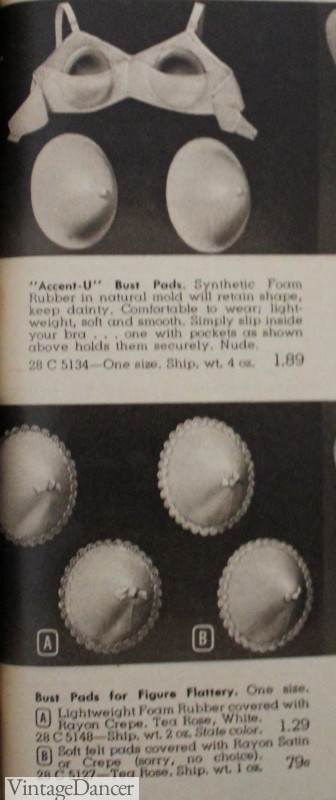
1947 Bust Pads (Note the false nipples)
Bust pads or falsies were necessary for many small chested women, including some famous Hollywood stars. Bust pads also helped average women fill out ready-made dress tops instead of altering the bodice down. In the USA it was estimated 5 million sets of bust pads were sold each year. Find falsies on Amazon.com
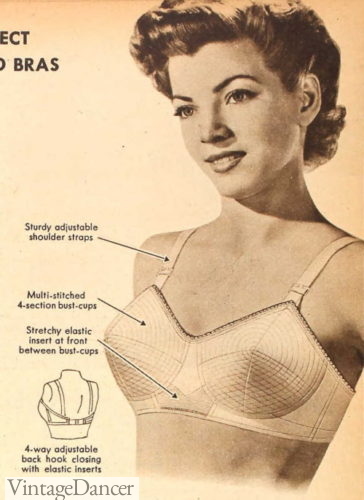
1949 cone bra or bullet bra with circular stitching
By the end of the 1940s, the very pointed bullet bra was coming into vogue. It was made pointy not by seams but with circular stitches creating a “cone” effect. The 1940s bra was not unrealistic.
Today’s bras tend to round out the breast while the 1940s breast was gently shaped into a moderate point. Vintage bra also spaced the breast further apart while modern bras push them together.
The 1950s bullet bra was to force the breast into an exaggerated point. The growth of bust pads and falsies doubled in the 1950s to accommodate the new, bigger, pointier, bust shape.
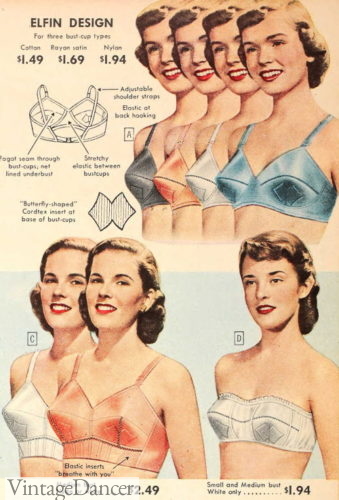
1949 Elfin or Bullet bras
1940s Style Bras
The best bras are usually cheap “granny” bras that come in boxes in the back corner of a department store. The styles have changed little since the 1940s.
Unlike modern T-shirt bras design to lift and round, vintage bras will separate and point the breasts slightly outward. Some good 1940s style bras are
- Bali Flowers Bra Underwire Bra – Amazon – Full range of cup sizes, very popular choice.
- Rago 2101 – Amazon- 34B up to 48DD.
- What Katie Did 1940s Bra – 32 to 38C and D.
- Playtex 18 Hour Bra – Amazon – Up to 48DDD. Simple and cheap!
- Dominique Bra No-Wire – Amazon – A,B,C cup. Soft and comfortable.
- Exquisite Form Original Fully Bra – Amazon – Soft pad cups.
- 1940s Brassiere Pattern – Sew your own bra.
- More vintage style bras
See more links to vintage style lingerie to buy.
1940s Underwear / Panties
Panties, also called step-ins or Combinations, were not worn much by women until the 1930s, These slip-like underwears were replaced by panty separates in the 1940s.
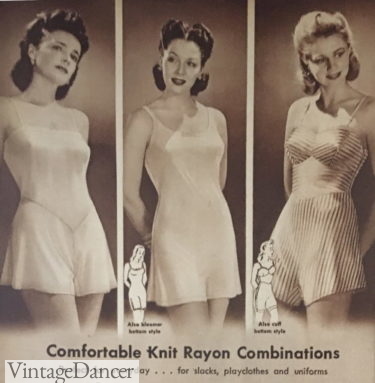
1942 step-in Combinations underwear
Panty separates had a few varieties: Flares leg (Tap Pants), Banded leg, Bloomers, and Briefs
1940s panties were made from rayon satin or cotton knit in colors similar to those used for bras and were plain. An elastic band at the top or a yoke with lacing kept them in place. They weren’t close-fitting or small – they reached up past the belly button and looked more like shorts than a bikini bottom.
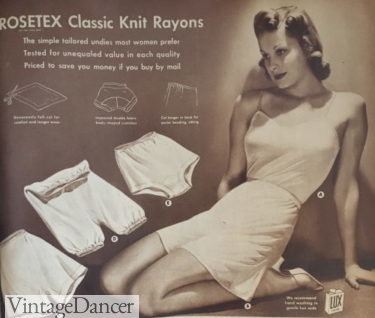
1942 underwear types- tap pant, bloomers and panty
Most panties came down a few inches on the legs but could be legless (like modern boy shorts) or full leg shorts down to the knee like a bloomers. Talk about coverage!
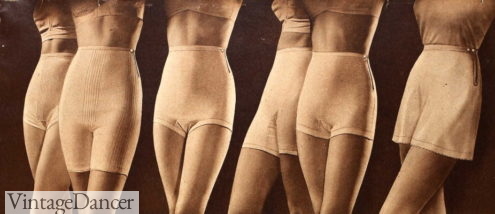
1944 cotton knit panties- brief, bloomer, brief, banded leg and flared legs
Some panties had control tops to double as a girdle. Other were loose at the leg (flared) or banded to prevent riding up. If a panty lacked an elastic waist they buttoned over to the left side.
Most panties were sold with matching “Vests” or what we call a camisole today.
In the 1940s the panty leg still had a bit of a band- they were not thigh revealing bikini style until much later. The legless brief style continued to grow in popularity as the decade marched into the 1950s.
- 1944 panty with control top
- 1946 flared leg, and bloomer panties
In winter, undergarments was made of knit cotton and even wool. They resembled Long Johns with legs from knee to ankle, and tops with long, short or sleeveless sleeves. They could also be worn in summer in light cottons too. While these were usually one piece items but they also came in top and bottom separates.
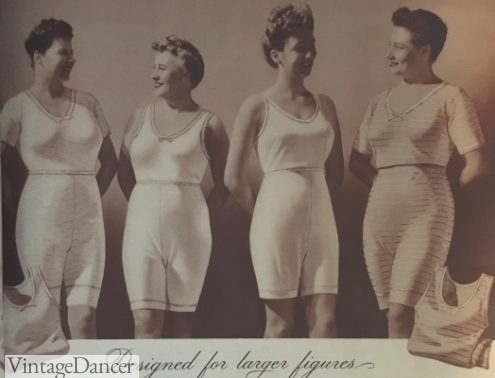
1944 women’s knit underwear
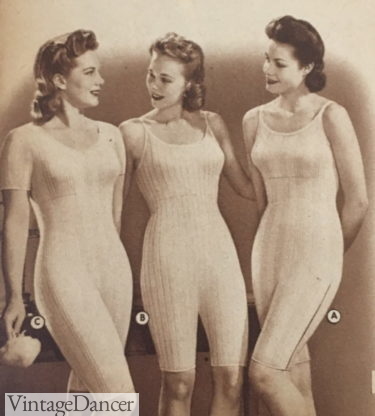
1942 winter weight underwear
Panties didn’t come with built in garter straps like girdles and wasitlettes did.
Separate garter belts were needed to hold up stockings.
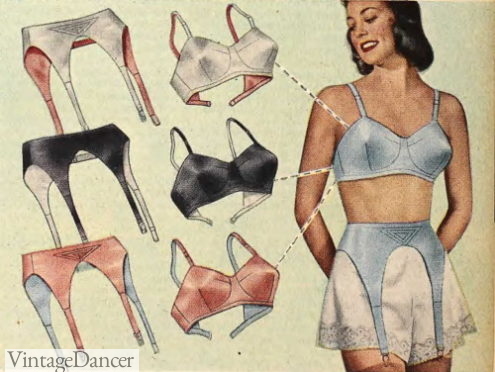
1948 garter belts and bra sets
Common fabrics include cotton, rayon, satin, brocades or all-elastic. Most have some elastic in them to hold them up around the hips or waist as well as in the clip attachments. The length of the garter straps can vary from 3 to 8 inches. Some came with an elastic waist to create an indented waistline.
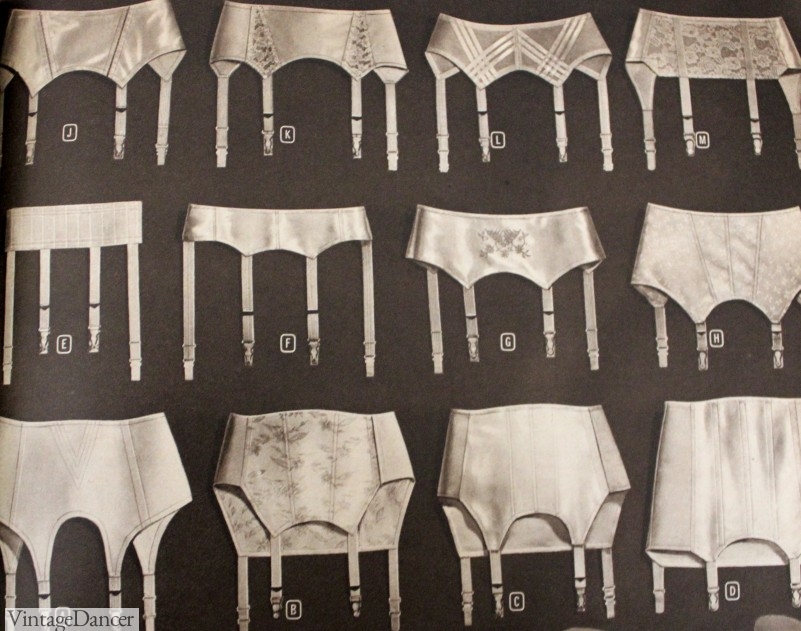
1944 Garter Belts
Another issue with just panties in summer is thigh sweat and rubbing (chub rub). Leg shields were made of rayon jersey that attached like a garter belt but had fabric down the inside of the leg and straps wrapping around the outside of the leg, hip sides, and buttox. They looked rather like a torture device but worked quite well.
For summer when socks were worn instead of stockings, girdle anchors were worn around the thighs to give something for the girdle or garter to clip to and stay flat.
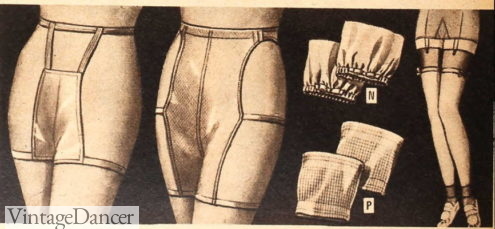
1945 leg shields and girdle anchors
1940s Style Underwear
Again, “granny” panties are the best. Get a tummy control high waist panty instead of a girdle for light to medium support. I also like long leg underwear/bloomer styles, especially when I’m not wearing stockings.
- Bali Tummy Control High Waist Panties – Amazon (My favorite).
- Rago 919 Tummy Control Panty – Amazon.
- Vanity Fair Lollipop – Traditional cotton panties
- Rago High Waist Girdle Brief 6106 – Panty and Girdle in one.
- 1940s Tap Panties – What Katie Did – Skirt like panties.
- Tap Pant– SIL – pretty lace trim tap pants.
- More vintage style panties and underwear
1940s Girdles
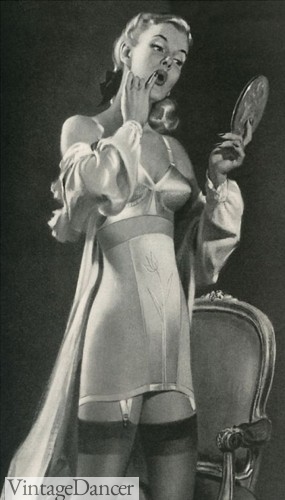
A model girdle and Bra set
Although girdles couldn’t be made in the same way that they were in the ’30s, they were produced and worn throughout the ’40s. They were praised for their shaping ability and posture improvements.
Girdles were made with rayon or cotton, and a small amount of elastic was allowed to be used to give them some stretch. They usually had some elastic panels on the front and back, the rest of the fabric being rigid. Steel boning at the back helped with posture correction.
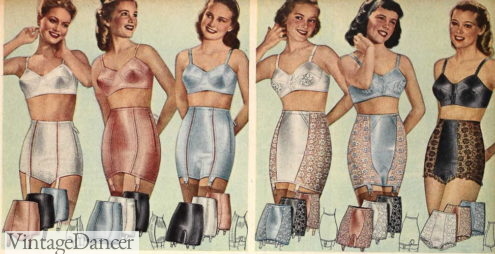
1948 girdles
The girdle was tight enough to shape well without sucking everything in, and reached to the waistline past the belly button. Full leg girdles would continue down into a skirt to cover the backside completely and had four elastic straps with metal clips to attach stockings, too.
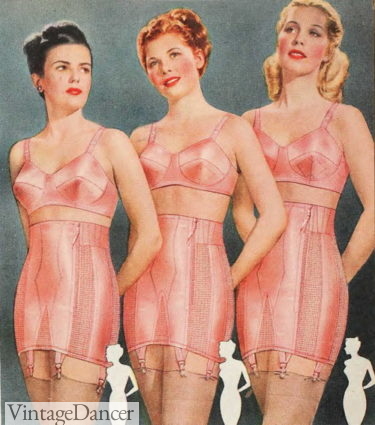
1947 girdles and bras
Since many women had begun to wear pants, a new type of ‘panty girdle’ started to be made. It was the same thing, except it took the form of a panty instead of a skirt. Girdles usually had metal zippers on one side to get in and out.
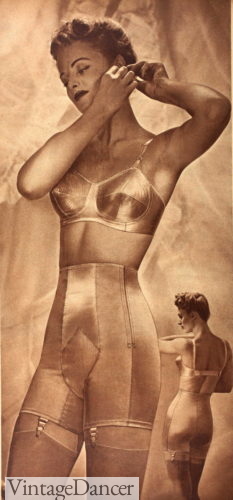
1944 panty-girdle
Although girdles offered a smooth shape underneath the new closer-fitting clothes, many women chose not to wear them at all during the decade, wearing just a bra and panties – something that had not been done before.
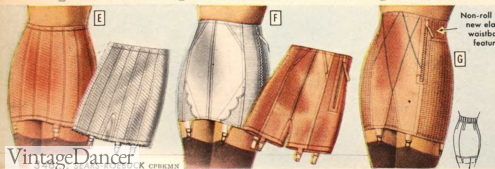
1949 girdles
1940s Style Girdles
Spanx has reinvented shapewear. While they are comfortable and good at smoothing, they don’t supply the structure most women need for a 1940s shape. Try one of these instead:
- Rago Pull On Open Bottom Girdle – Amazon.
- Open Girdles – SIL
- More girdles, garters, waist shapers and corsets
All In One
While the elastic girdle was for slim to average sized women, a full figured woman needed a corset or corselette. These were usually steel boned and made with very heavy materials to provide maximum support and shaping.
Since it combined a full bra, girdle, and hip coverage, the silhouette was perfectly smooth – no bumps and rolls anywhere.
- 1942 All In One
- 1948 lace top All In One
Corselettes, also called All-in-Ones, are lighter versions of the heavy corset, although heavy versions could still be called corselettes. The corset was an old name, conjuring up thoughts of restrictive Victorian era shapewear – a thought most women in the 1940s wanted to avoid.
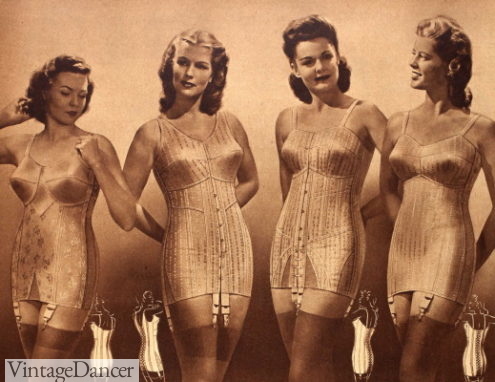
1944 All In One combinations
Whether girdle, corset or All-in One corselette, it served one more shaping purpose: the indent or waist nipper. A sharp indentation 2-3 inches above the belly button and just below the rib cage was part of the ideal 1940s silhouette. This provided the hour glass shape the 1940s were known for.
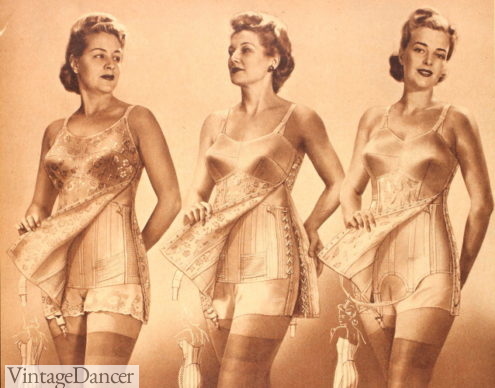
1944 inner girdle with outer All in One
Dress bodices were tailored to end right at this indention and skirts to begin and hang over the hips and stomach. The hips were never confined in ’40s girdles- only covered to smooth and shape gently. Remember that during the war women had to work, move, and bend in their girdles – there was no use for any confining 1940s undergarments.
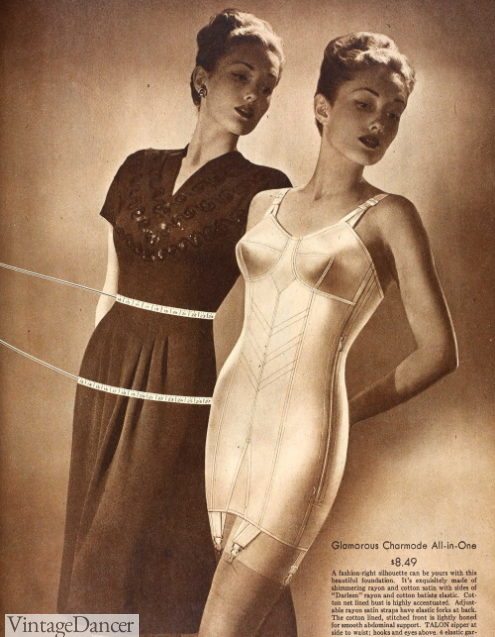
1946 All In One
It was less critical in the 1940s to have small proportions all around as it was to have the illusion of a small waist and full hips. This is one reason dressing in 1940s dresses are more flattering on a full spectrum of women’s shapes and sizes.
- The All In One is not something available today. The closest match is a full body shapewear (skirt or shorts) with attached bra. The tend to squish outward rather then create a smooth, flat, front and hip like a real All In One would.
1940s Slips
Slips were the last underwear layer a lady needed to create the perfect shape. Nine out of ten women wore slips on top of their foundation garments and under outer garments.
Slips came in long dress-like varieties or shorter shirt and top only selections. Slips were usually white, black, or soft peachy pink, with sheer dresses often coming with matching color slips for the best look.
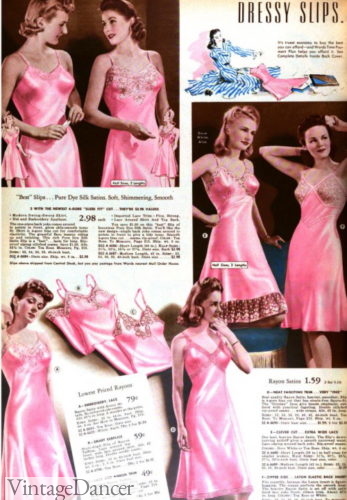
1941 pink slips
Silk or rayon made the best slips while cotton knit was the most affordable slip, but prone to bunching at the knees and sticking to the inside of dresses. Taffeta slips retained body heat and were not worn in hot weather.
Slips had adjustable thin shoulder straps and a figure flattering bias cut shape or straight cut gores. They were full length but short 2 inch of the overdress. Showing a but of slip was taboo.
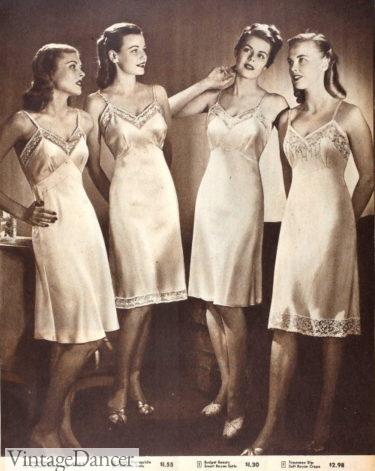
1946 slips
The slip top either came in a V-neck cut for a dress or a square neck cut for blouses. Deep round cut slips were available to fit certain styles as well.
Slips for fancy occasions had lace trim, otherwise specific adornment was considered necessary and likely to wear out faster than the slip material. No dress, suit or skirt would be complete without a slip to keep clothing from clinging to the body.
- 1946 cotton knit winter slip
- 1949 knit slips
Half slips or petticoats were waist down slips. They were popular with young girls and women who wore dark skirts and light but not sheer blouses. A knit cami top was often worn with half slips.
Taffeta petticoats added a “swish” sound under dresses, making them appealing to teens and single women looking to attract attention. They were A-line with a wide ruffle at the hem at first, but started to gain volume around 1947 when the New Look became the new fashionable style of the 1950s.
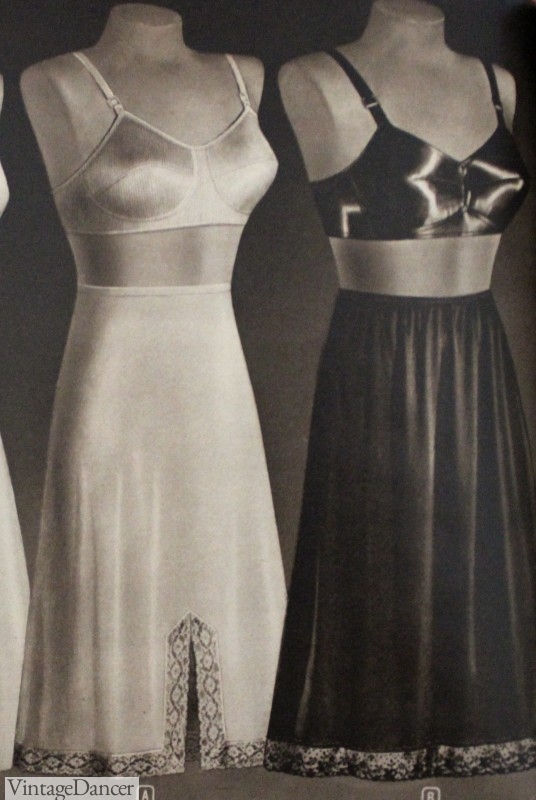
Half Slips
For the average woman, full 1950s style petticoats were not worn yet. Skirt fullness was achieved with the cut of the skirt and not with the aid of a fluffy petticoat.
Until then, slips and half slips were straight or a-line cut with maybe one ruffle at the bottom for a little volume. Fuller petticoats were worn with long evening ballgowns throughout the 1940s, but even those were not the full shapes of the 1950s.
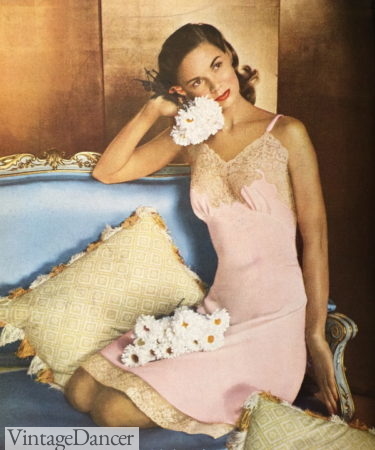
1947 pink lace slip
Dressing in 1940s Lingerie, in Order
What order did women put on lingerie? Here is how 1940s women dressed:
- Brassiere,
- Girdle, panty girdle, or All-In-One
- Panties*
- Stockings – Some women put stockings on first and then the girdle/garter clips. Shoe were also put on after stockings.
- Garter, if separate than above, then
- Slip or camisole and petticoat.
* In many cases a detached garter was put on before the panties. These kept them in place against skin. In fashion ads, the garter was worn outside the panties for modesty and promotion reasons.
There was a variety of personal preference in what order a woman was dressed in the 1940s. Less flexible woman may have dresses from the bottom up, while younger women, from the top down, or something in-between. For you own needs, try a few orders to find the right one for you.
Where to buy 1940s vintage inspired lingerie:
See more vintage repro lingerie brands to shop from.
Debbie Sessions has been teaching fashion history and helping people dress for vintage themed events since 2009. She has turned a hobby into VintageDancer.com with hundreds of well researched articles and hand picked links to vintage inspired clothing online. She aims to make dressing accurately (or not) an affordable option for all. Oh, and she dances too.
